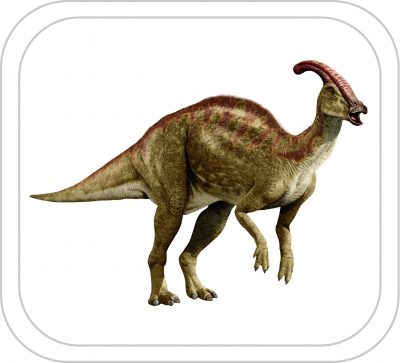Parasaurolophus
Name: Parasaurolophus
Pronounced: pa-ra-saw-ROL-off-us
Meaning: ‘Near crested lizard’
Period: Late Cretaceous (76 – 74 million years ago)
Group: Ornithopods (bird feet)
Size: It was 11m long and 5.2m tall. It weighed about 2000kg.
Diet: Herbivore.
Characteristics: The Parasaurolophus walked on both two and four legs. It had pebbly-textured skin, a beak-like nose and a prominent cranial crest up to 1.8 m long, protruding above its head. There has been a lot of debate over the use of the crest. Males may have had longer crests than females, so it has been suggested the crest was used in courtship displays. Some claim it was used to produce a low-frequency, foghorn-like sound. Some believe it enhanced its sense of smell as its nostrils went up from the end of its nose, through the crest and back down, forming four tubes. It was suggested it acted like a snorkel so they could spend long periods of time in the water, but since there was no nostril at the top, this theory has been rejected. Its web-like fossilised hands also suggested it may have lived in water but many argue these particular fossils became misshapen during the fossilisation process. Also, studies of fossilised stomach contents, showed it mostly ate land plants such as pine needles and other tree leaves, indicating it spent most of its time on land. The Parasaurolophus is believed to have been a herding animal that migrated from shorelines to higher ground to reproduce.
Named by: William Arthur Parks in 1922
Discovery: The Parasaurolophus was first described in 1922 by William Parks from a skull and partial skeleton discovered in Alberta, in Canada. Many other fossil remains have been found in New Mexico and Utah, in North America.

